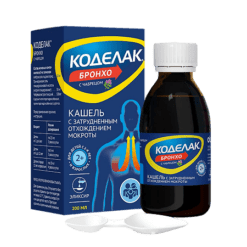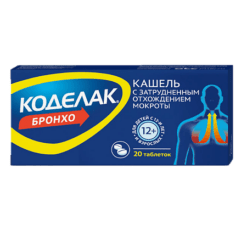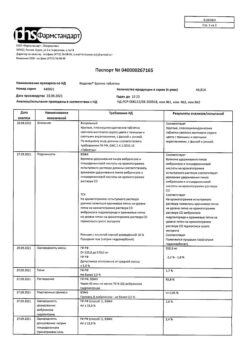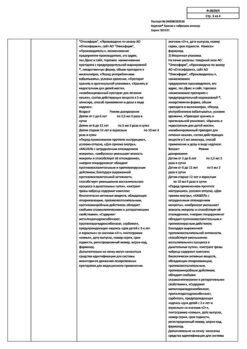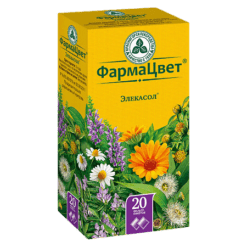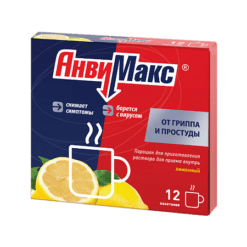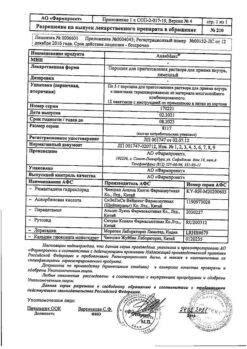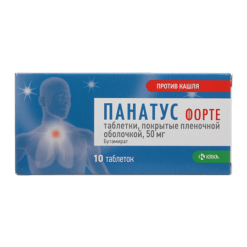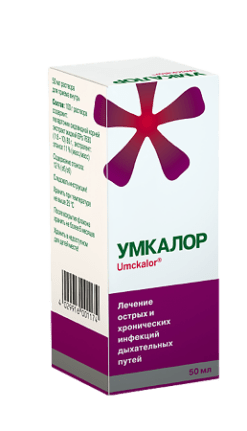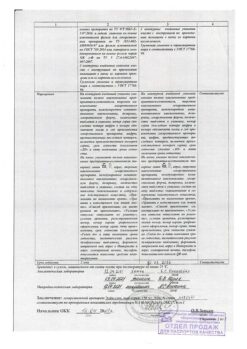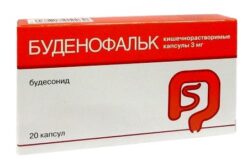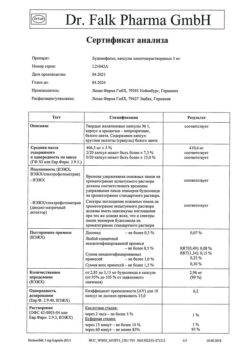No products in the cart.
Codelac Broncho, tablets 10 pcs
€5.25 €4.37
Description
Pharmacotherapeutic group: expectorant combination medicine
ATX code: [R05CA10]
Pharmacological properties
Pharmacodynamics
Compound medicine for the treatment of cough, has mucolytic and expectorant effects, as well as anti-inflammatory activity. The action of Codelac ® Broncho is due to the pharmacological properties of its components:
Ambroxol has secretomotor, secretolytic and expectorant action, normalizes the disturbed ratio of serous and mucous components of sputum, increases the secretion of surfactant in the alveoli. It reduces the viscosity of sputum and promotes its expulsion.
On average when taken orally the action of ambroxol occurs within 30 minutes, duration of action is 6-12 hours depending on the dose taken.
Glycyrrates (glycyrrhizic acid and its salts) have anti-inflammatory and antiviral effects. It has cytoprotective effect due to antioxidant and membrane stabilizing activity. It potentiates the effect of endogenous glucocorticosteroids, having anti-inflammatory and anti-allergic effects. Due to a pronounced anti-inflammatory activity, it helps to reduce the inflammatory process in the respiratory tract.
The extract of Thermopsis has expectorant effect, with moderate irritant effect on the mucous membrane receptors of the stomach, increases by reflex the secretion of bronchial glands.
Sodium bicarbonate shifts index of the environment (pH) of bronchial mucus to the alkaline side, reduces sputum viscosity and stimulates motor function of the scimitar epithelium and bronchioles.
Pharmacokinetics
Ambroxol.
Absorption. Ambroxol is characterized by rapid and almost complete absorption from the gastrointestinal tract. Bioavailability is 70-80%. Maximum concentration in blood plasma after oral administration is reached after 1-3 hours. Binding to plasma proteins is 80-90%.
Distribution. Transition of ambroxol from the blood to the tissues when administered orally is fast. The highest concentrations of the active component of the drug are observed in the lungs. Passes through the blood-brain barrier, placental barrier, excreted with breast milk.
Metabolism. Approximately 30% of the oral dose undergoes a “primary passage” effect through the liver. Studies on human liver microsomes have shown that the CYP3A4 isoenzyme is the predominant isoenzyme responsible for the metabolism of ambroxol. The remainder of ambroxol is metabolized in the liver to inactive metabolites.
Elimination. The half-life (T ½) of ambroxol is about 10 hours. Excreted by the kidneys: 90% as metabolites, 10% unchanged.
Pharmacokinetics in special groups of patients. No clinically significant effect of age and sex on ambroxol pharmacokinetics has been found, so there is no reason to adjust the dose according to these characteristics.
The ambroxol clearance in patients with severe hepatic impairment is reduced by 20-40%.
In severe renal failure, the T ½ of ambroxol metabolites is increased.
Sodium glycyrrhizinate (trisodium salt of glycyrrhizic acid).
After oral administration, in the intestine under the influence of the enzyme β-glucuronidase produced by bacteria of normal microflora, from glycyrrhizic acid is formed the active metabolite – β-glycyrrhetic acid, which is absorbed into the systemic bloodstream. In the blood β-glycyrrhetic acid binds with albumin and is almost completely transported to the liver. Excretion of β-glycyrrhetic acid occurs mainly in the bile, with residual amounts in the urine.
Thermopsis lanceolate herb extract.
The components of the extract are well absorbed in the gastrointestinal tract. Maximum effect occurs 30-60 minutes after ingestion and lasts for 2-6 hours. It is excreted from the body by the kidneys, respiratory mucosa and bronchial glands.
Sodium bicarbonate.
It is well absorbed in the gastrointestinal tract. Maximum effect occurs 30-60 min after oral administration and lasts for 2-6 hours. It is eliminated from the body by the kidneys, respiratory mucosa and bronchial glands.
.
Indications
Indications
Respiratory tract diseases with difficulty
sputum discharge: acute and chronic bronchitis, pneumonia, chronic obstructive
pulmonary disease (COPD), bronchiectasis.
Pharmacological effect
Pharmacological effect
Pharmacotherapeutic group: expectorant combined drug
ATX Code: [R05CA10]
Pharmacological properties
Pharmacodynamics
A combined drug for the treatment of cough, it has a mucolytic and expectorant effect, and also has anti-inflammatory activity. The action of Codelac® Broncho is due to the pharmacological properties of its components:
Ambroxol has a secretomotor, secretolytic and expectorant effect, normalizes the disturbed ratio of serous and mucous components of sputum, and increases the secretion of surfactant in the alveoli. Reduces the viscosity of sputum and promotes its removal.
On average, when taken orally, the effect of ambroxol occurs within 30 minutes, the duration of action is 6-12 hours, depending on the dose taken.
Glycyrrhat (glycyrrhizic acid and its salts) has anti-inflammatory and antiviral effects. It has a cytoprotective effect due to its antioxidant and membrane-stabilizing activity. Potentiates the effect of endogenous glucocorticosteroids, providing anti-inflammatory and antiallergic effects. Due to its pronounced anti-inflammatory activity, it helps reduce the inflammatory process in the respiratory tract.
Thermopsis extract has an expectorant effect, having a moderate irritant effect on the receptors of the gastric mucosa, and reflexively increases the secretion of the bronchial glands.
Sodium bicarbonate shifts the pH of bronchial mucus to the alkaline side, reduces the viscosity of sputum, and stimulates the motor function of the ciliated epithelium and bronchioles.
Pharmacokinetics
Ambroxol.
Suction. Ambroxol is characterized by rapid and almost complete absorption from the gastrointestinal tract. Bioavailability is 70-80%. The maximum concentration in blood plasma after oral administration is achieved within 1-3 hours. Plasma protein binding is 80-90%.
Distribution. The transition of ambroxol from the blood to tissues when taken orally occurs quickly. The highest concentrations of the active component of the drug are observed in the lungs. Penetrates the blood-brain barrier, placental barrier, and is excreted in breast milk.
Metabolism. Approximately 30% of an ingested dose undergoes a first pass effect through the liver. Studies on human liver microsomes have shown that CYP3A4 is the predominant isoenzyme responsible for the metabolism of ambroxol. The remainder of ambroxol is metabolized in the liver to inactive metabolites.
Excretion. The half-life (T ½) of ambroxol is about 10 hours. Excreted by the kidneys: 90% in the form of metabolites, 10% unchanged.
Pharmacokinetics in special groups of patients. No clinically significant effect of age and gender on the pharmacokinetics of ambroxol was found, so there is no basis for dose adjustment based on these characteristics.
The clearance of ambroxol in patients with severe liver failure is reduced by 20-40%.
In severe renal failure, T ½ of ambroxol metabolites increases.
Sodium glycyrrhizinate (trisodium salt of glycyrrhizic acid).
After oral administration, in the intestine, under the influence of the enzyme β-glucuronidase, produced by bacteria of normal microflora, an active metabolite is formed from glycyrrhizic acid – β-glycyrrhetic acid, which is absorbed into the systemic circulation. In the blood, β-glycyrrhetic acid binds to albumin and is almost completely transported to the liver. The excretion of β-glycyrrhetic acid occurs predominantly in bile, with residual amounts in urine.
Thermopsis lanceolata herb extract.
The components of the extract are well absorbed in the gastrointestinal tract. The maximum effect occurs 30-60 minutes after oral administration and lasts for 2-6 hours. They are excreted from the body by the kidneys, mucous membrane of the respiratory tract and bronchial glands.
Sodium bicarbonate.
Well absorbed from the gastrointestinal tract. The maximum effect occurs 30-60 minutes after oral administration and lasts for 2-6 hours. Excreted from the body by the kidneys, mucous membrane of the respiratory tract and bronchial glands.
Special instructions
Special instructions
Do not combine with antitussives.
Active ingredient
Active ingredient
Ambroxol, Sodium bicarbonate, Sodium glycyrrhizinate, Thermopsis extract
Composition
Composition
Active ingredients:
ambroxol hydrochloride (ambroxol) – 20.0 mg,
sodium glycyrrhizinate (trisodium salt of glycyrrhizic acid) – 30.0 mg,
Thermopsis lanceolata herb extract – 10.0 mg,
sodium bicarbonate – 200.0 mg.
Excipients:
potato starch – 84.30 mg, microcrystalline cellulose – 150.10
mg, povidone (polyvinylpyrrolidone, povidone K25) – 26.40 mg, talc – 13.00 mg,
stearic acid – 5.20 mg,
sodium carboxymethyl starch (sodium starch glycolate) – 11.00 mg.
Pregnancy
Pregnancy
Use of the drug during pregnancy
contraindicated. If necessary, use the drug during lactation
breastfeeding should be stopped.
Contraindications
Contraindications
Hypersensitivity to the components of the drug, pregnancy, breastfeeding, children under 12 years of age.
With caution
For liver and/or kidney failure, gastric and duodenal ulcers, bronchial asthma.
Side Effects
Side Effects
Allergic reactions.
Rarely – weakness, headache, diarrhea, dry mouth and respiratory tract, exanthema, rhinorrhea, constipation, dysuria. With long-term use in high doses – gastralgia, nausea, vomiting.
Interaction
Interaction
Combined use with antitussive drugs leads to difficulty in sputum discharge while reducing cough.
The drug increases the penetration of antibiotics into the bronchial secretions.
Shelf life
Shelf life
2 years.
Manufacturer
Manufacturer
Pharmstandard-Leksredstva, Russia
Additional information
| Shelf life | 2 years. |
|---|---|
| Manufacturer | Pharmstandard-Leksredstva, Russia |
| Medication form | pills |
| Brand | Pharmstandard-Leksredstva |
Other forms…
Related products
Buy Codelac Broncho, tablets 10 pcs with delivery to USA, UK, Europe and over 120 other countries.


